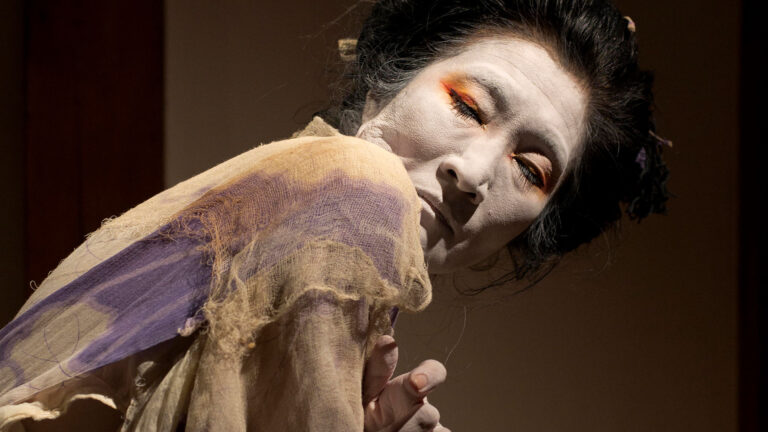talk + performanceThe heretical body. Butō dance from birth to todayQuantum Activism
Carlo Scarpa hall and Museum spaces
entrance € 5
curated by Maria Pia D’Orazi
Monday closed
Tuesday to Sunday 11 am – 7 pm
Monday 8 December 11 am > 7 pm
Wednesday 24 December 11 am > 4:30 pm
Thursday 25 December closed
Wednesday 31 December 11 am > 4:30 pm
Thursday 1 January 11 am > 7 pm
Monday 5 January 11 am > 7 pm
Tusday 6 January 11 am > 7 pm
– for young people aged between 18 and 25 (not yet turned 25);
– for groups of 15 people or more;
– La Galleria Nazionale, Museo Ebraico di Roma ticket holders;
– upon presentation of ID card or badge: Accademia Costume & Moda, Accademia Fotografica, Biblioteche di Roma, Centro Sperimentale di Cinematografia, Enel (for badge holder and accompanying person), FAI Fondo Ambiente Italiano, Feltrinelli, Gruppo FS, IN/ARCH Istituto Nazionale di Architettura, Sapienza Università di Roma, LAZIOcrea, Palazzo delle Esposizioni, Amici di Palazzo Strozzi, Accademia Nazionale di Santa Cecilia, Scuola Internazionale di Comics, Teatro Olimpico, Teatro dell’Opera di Roma, Teatro di Roma, Università degli Studi di Roma Tor Vergata, Youthcard;
valid for one year from the date of purchase
– minors under 18 years of age;
– myMAXXI cardholders;
– on your birthday presenting an identity document;
– upon presentation of EU Disability Card holders and or accompanying letter from hosting association/institution for: people with disabilities and accompanying person, people on the autistic spectrum and accompanying person, deaf people, people with cognitive disabilities and complex communication needs and their caregivers, people with serious illnesses and their caregivers, guests of first aid and anti-violence centres and accompanying operators, residents of therapeutic communities and accompanying operators;
– MiC employees;
– journalists who can prove their business activity;
– European Union tour guides and tour guides, licensed (ref. Circular n.20/2016 DG-Museums);
– 1 teacher for every 10 students;
– AMACI members;
– CIMAM International Committee for Museums and Collections of Modern Art members;
– ICOM members;
– from Tuesday to Friday (excluding holidays) European Union students and university researchers in art history and architecture, public fine arts academies (AFAM registered) students and Temple University Rome Campus students;
– IED Istituto Europeo di Design professors, NABA Nuova Accademia di Belle Arti professors, RUFA Rome University of Fine Arts professors;
– upon presentation of ID card or badge: Collezione Peggy Guggenheim a Venezia, Castello di Rivoli Museo d’Arte Contemporanea, Sotheby’s Preferred, MEP – Maison Européenne de la Photographie;
limited seating; it is mandatory to arrive at the infopoint 15 minutes before the start time indicated on the ticket; the experience lasts approximately 45 minutes
limited seating; it is mandatory to arrive at the infopoint 15 minutes before the start time indicated on the ticket; the experience lasts approximately 45 minutes
MAXXI’s Collection of Art and Architecture represents the founding element of the museum and defines its identity. Since October 2015, it has been on display with different arrangements of works.

Carlo Scarpa hall and Museum spaces
entrance € 5
curated by Maria Pia D’Orazi
17 Dec 2025 05.00 pm
MAXXIperTUTTIThe Large Glass: plural visionsfree guided tours
17 Dec 2025 06.00 pm
lectureRicky BurdettIl DNA delle città: leggere Roma nel contesto globale
18 Dec 2025 05.00 pm
MAXXIperTUTTI1+1 sensitactile labs
26 Dec 2025 11.30 am
guided toursThe Large Glass
26 Dec 2025 04.30 pm
MAXXI with the familyMeraviglie in equilibrioCostruire come Pier Luigi Nervi
26 Dec 2025 04.30 pm
guided toursThe Large Glass



Butō today is an internationally established reality. It is a way of going beyond forms and tapping into the energy that created them..
The spread of butō has led to a crystallisation of forms, which has opened up new questions about its nature and its ability to critically reflect the present time. Akira Kasai – who took part in the founding performances of butō in the 1960s – has been dealing with these questions ever since he developed an original path, nourished by his encounter with Rudolf Steiner’s Eurythmy, and in his latest works he has expressly set out to revive the creative force that produced butō, reworking performances from the early days and launching a new project that he has defined post-butō
speaker
Maria Pia D’Orazi journalist and theatre historian
Reiji Kasai dancer and eurythmist (translation: Daisuke Kurihara)
performance
Human Flourishing by and with Chiara Clara Burgio
One soul, two incarnations by and with Reiji Kasai, Naoka Uemura, Hiroko Asami (Reiji Kasai Company)
On the occasion of the exhibition TOKYO REVISITED, by Daido Moriyama with Shomei Tomatsu, MAXXI presents Il corpo eretico, three appointments designed to recount the transformations of butō dance from its origins to the present day. These are accompanied by live performances by Japanese and Italian dancers in the museum spaces.
The cycle starts in the 1960s, when a community of artists literally took to the streets inventing new languages destined to change the official narrative of the country and leave a lasting trace. Tokyo becomes both a performance space and the disturbing double of an unstoppable human mutation. Physicality is the trait that unites the experiments of the avant-garde and revolutionises all representative codes, in a climate of exchange and collaboration between dance, photography, cinema, painting, design and literature. It is a dense, anarchic, erotic corporality, disobedient to all rules, and is nourished by the radical explorations of Tatsumi Hijikata, the founder of butō dance.
individual seats reserved for myMAXXI cardholders by writing to mymaxxi@fondazionemaxxi.it, by the day before the event